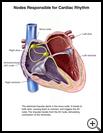
Paroxysmal Supraventricular Tachycardia (Fast Heartbeat)
________________________________________________________________________
KEY POINTS
- Paroxysmal supraventricular tachycardia is a very fast heartbeat that comes and goes.
- Your child may not need treatment if the attacks are rare, don’t last long, and don’t cause serious symptoms.
- Treatment may include medicine or procedures to shock the heart, or to block abnormal electrical pathways, so that the heart beats normally.
________________________________________________________________________
What is paroxysmal supraventricular tachycardia?
Paroxysmal supraventricular tachycardia (PSVT) is a very fast heartbeat that comes and goes.
What is the cause?
An electrical signal in your heart starts each heartbeat, causing the heart muscle to squeeze (contract). Normally, this signal starts in the upper right chamber of the heart (the right atrium) at a place called the sinus node. The signal then follows normal pathways to the upper left atrium and to the lower chambers of the heart (the ventricles). Sometimes the electrical signals don’t follow the normal pathways. This may make the heart beat very fast.
A fast heartbeat in infants and children may be caused by stress, exercise, fever, medicines, or by an extra electrical pathway connecting the upper and lower chambers. When the electrical signal goes down both pathways at the same time, the heart beats normally. If the electrical signal goes down one pathway faster than the other, it can then go back up the extra pathway, making the heart beat very fast.
Other causes of PSVT include heart disease, heart infections, health problems such as lung disease or an overactive thyroid gland, alcohol or drug abuse, caffeine, or smoking.
What are the symptoms?
Symptoms of PSVT may be mild or severe. Symptoms may include:
- Feeling like the heart is beating too fast or too hard or skipping beats or fluttering
- Feeling weak, dizzy, or lightheaded
- Fainting
- Shortness of breath
- Chest tightness
How is it diagnosed?
The healthcare provider will ask about your child’s symptoms and medical history and examine your child. Tests may include:
- An ECG (also called an EKG), which measures and records your child’s heartbeat. Your child may have an ECG while resting or while exercising on a treadmill. Your child may also be asked to wear a small portable ECG monitor for a few days or sometimes a couple of weeks.
- Blood tests
- Chest X-ray
- An electrophysiology study (EPS), which uses tiny wires put into your child’s heart through the veins to look at the electrical pathways in the heart
How is it treated?
The goal of treatment is to help the heart keep a normal rhythm. Your child’s treatment depends on the cause of the PSVT, how often your child has symptoms, and the severity of the symptoms.
Infants often outgrow PSVT by 6 to 12 months of age. Your child may not need treatment if the attacks are rare, don’t last long, and don’t cause serious symptoms. For most children, PSVT starts suddenly and lasts just a short time. The heart goes back to a normal rhythm on its own. If your child keeps having spells of PSVT, treatment may help keep your child from having so many spells.
Your healthcare provider can show your child ways to stop a spell of PSVT. Other possible treatments are:
- Medicine to control the heart rate
- Electrical cardioversion: Your child will be given medicine called anesthesia to keep from feeling pain during the procedure. Then your child’s chest will be given an electrical shock. The electrical shock should make your child’s heart start beating normally again. Your child may need medicine to keep the heart rhythm normal after this procedure.
- Ablation: Ablation is a procedure that uses a small tube called a catheter to deliver energy to the inside of the heart. The energy (usually radio waves) scars small areas of heart tissue. The scars block abnormal electrical pathways and help your child have a normal heart rhythm. With some types of ablation treatment, your child may also need a pacemaker. A pacemaker is an electronic device put under the skin of your child’s chest to help control the heartbeat.
How can I take care of my child?
Follow the full course of treatment prescribed by your child's healthcare provider. Ask your child’s provider:
- How and when you will get your child’s test results
- How long it will take your child to recover
- If there are activities your child should avoid and when your child can return to normal activities
- How to take care of your child at home
- What symptoms or problems you should watch for and what to do if your child has them
Make sure you know when your child should come back for a checkup. Keep all appointments for provider visits or tests.
Last modified: 2017-03-28
Last reviewed: 2017-03-21

